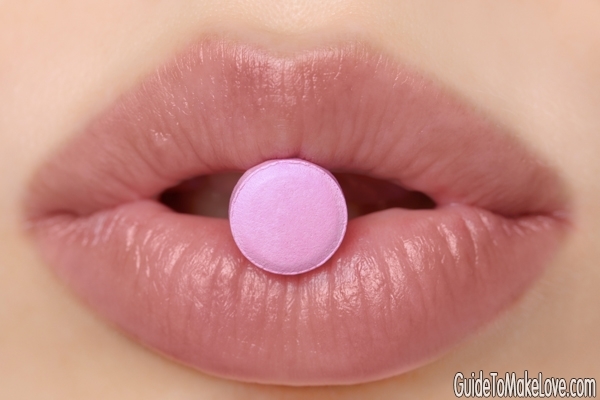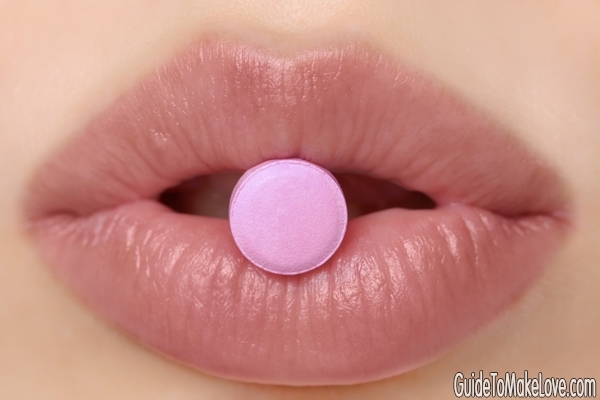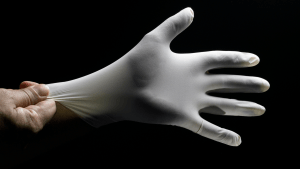
Pleasure in a Pill?

AS SOON AS SHE WOKE UP on a warm summer morning in Baltimore, Cara, a development director for a local nonprofit, was eager to have sex. But with two small children and an airtight morning routine, she and her husband, Ryan, didn’t have time. So Cara, 38, placed three envelopes on the dashboard of Ryan’s truck. “Open them when you get to work,” she said. In the first envelope, Ryan found instructions to pick up oysters during his lunch break. Envelope two asked him to swing by a wine store. Number three only said “12 p.m.,” along with the name of a local hotel. “I met him at the door wearing only heels,” says Cara now. “Building that anticipation all morning was incredibly sexy. Things hadn’t been that hot between us in years.”
Cara is convinced that their steamy rendezvous wouldn’t have happened if she hadn’t been taking a pill called flibanserin, intended to treat hypoactive sexual desire disorder (HSDD), defined as a drop in a woman’s sex drive that lingers for at least six months. (As of 2013, it’s known as SIAD, sexual interest/arousal disorder.) In the first few years of their relationship, Ryan and Cara (their names have been changed to protect their privacy) had sex at least five times a week. “We had amazing sexual chemistry,” Cara says. “I couldn’t understand how people got to work in the morning. Why wouldn’t you just do it all the time?” But after their first child was born, Cara’s sex drive dropped off dramatically and never rebounded. “I didn’t look or feel the same,” she says. “My body had always been mine, and now it served a totally different purpose as a mother.”
She spent the better part of her 30s on a quest to reboot her sex drive, trying herbal supplements, date nights, and therapy. Nothing worked. Sex sounded exhausting on top of everything else she was juggling. So Cara stopped initiating it. When Ryan tried, she pushed him away or pretended to be asleep. “That broke his heart,” she says. “He’d be lying next to me and I could just feel his anger and sadness in the air.” One day, Ryan showed her a newspaper ad describing a clinical trial for flibanserin. Cara signed up right away.
A few weeks into the study, she felt her sex drive wake up, and Cara’s entire sense of herself changed. “Flibanserin helped me remember that person I used to be,” she says. She planned more lunchtime meet-ups, or grabbed her husband for a quickie while the kids were watching cartoons. They went from having obligation sex once every other week to having sex twice a week. Ryan started doing more around the house, going from “sulking on the couch in the evenings to pouring me a glass of wine and asking about my day,” she recalls. Cara started exercising more and feeling better about her body. “There were ripple effects through every aspect of our lives,” she says.
Then the yearlong study ended, and so did Cara’s supply. She would have to wait until the U.S. Food and Drug Administration reviewed the study results and agreed to put flibanserin on the market. Six years later, Cara is still waiting. Her sex drive has been AWOL ever since.
In 1998, the FDA approved sildenafil citrate, a pill marketed as Viagra, to treat impotence in men. In its first week on the market, almost 40,000 prescriptions were written. By 2012, Viagra and its competitors Cialis, Levitra, and Stendra accounted for $ 4.3 billion in annual sales. Expecting similar success, pharmaceutical companies have invested billions in drugs they claim will improve women’s sexual performance. But as of press time, the FDA had rejected them all.
Cara can’t understand why the FDA green-lit Viagra after just six months of research, while she’s been left hanging. “It’s got to be men making these decisions,” she says. “If it were women, this thing would’ve been on the market years ago.” Actually, the FDA’s top official and its director of the Center for Drug Evaluation and Research (which is responsible for evaluating drugs before they can be sold) are both women, and the agency has approved two drugs for both postmenopausal vaginal dryness and pain during intercourse. But Cara isn’t alone in her suspicion that a double standard is at work. Almost 9 percent of women ages 18 to 44 suffer from HSDD, according to a study of more than 31,000 American women published in Obstetrics & Gynecology in 2008, the most recent data available. “This is a recognized medical condition, and yet we have no approved treatments for it,” says Terry O’Neill, president of the National Organization for Women. “Of course it’s the FDA’s job to worry about safety. But we also have a long history of neglect when it comes to prioritizing women’s medical needs in this country. And there seems to be this pervasive cultural sense that women don’t really need sexual desire.”
In 2013, O’Neill wrote a letter to the FDA encouraging the agency to give equal consideration to sexual-desire drugs aimed at women. She also supported Even The Score, a campaign for women’s sexual-health equality, launched by the two pharmaceutical companies currently developing women’s sex drugs, along with a dozen consumer, women’s, and health groups. Even The Score’s website includes an online petition and letter-writing campaign to prod the FDA to revisit flibanserin and several other drugs it previously rejected, and this past fall, the FDA held a public meeting to discuss female sexual dysfunction and solicit input from patients and researchers alike.
But not every feminist and women’s health organization has joined the fight. In fact, a significant number of sexuality researchers aren’t convinced that we need a female sex drug at all. “The pharmaceutical industry wants people to think that sexual problems are simple medical matters, and it offers drugs as expensive magic fixes,” argues Leonore Tiefer, Ph.D., a clinical professor of psychiatry at NYU School of Medicine. Tiefer is skeptical of Even The Score, which she considers more PR stunt than grassroots activism. She’s spent the past 14 years running the New View Campaign, a coalition of 10 major women’s and health groups, including Planned Parenthood of New York City, along with more than 100 doctors and social scientists. Its mission is to challenge what she calls “the medicalization of sex” for both men and women. The campaign’s researchers have testified against the approval of female sex drugs at both FDA hearings to date. Tiefer thinks we should be fighting to change our culture—which, she argues, perpetuates negative messages and unrealistic expectations about women and sex via porn, music, and other media—instead of big pharma.
So is the FDA really discriminating against women? Or is female sexuality too complicated to be treated by a pill?
ONE THING BOTH sides agree on: Finding an effective female sex drug isn’t as easy as putting Viagra in a pink bottle. To understand why, it helps to distinguish between “desire”—your mental state of feeling turned on—and “arousal,” in which your body signals that it wants to get it on (vaginal wetness, hardened nipples, and so on). Some women experience spontaneous-seeming arousal frequently (often at certain points in the menstrual cycle), and just noticing those physical signs will get them in the mood. But other women, especially those diagnosed with SIAD, are less aware of the physical signs of arousal. And triggering desire without physical cues is a complicated mental process. “You can’t wait for desire to simply rise up, spontaneously,” explains Tiefer. “It’s like getting in the mood to watch a movie. You have to think about what you like and what circumstances are conducive to that.”
Arousal and desire are more consistently linked for men because their main physical cue is so, well, obvious. “Men know if they have an erection, so that tends to trigger the mental desire,” says Lori Brotto, Ph.D., director of the Sexual Health Laboratory at the University of British Columbia in Vancouver, who defined the criteria for female sexual dysfunction disorders for the latest edition of the Diagnostic and Statistical Manual of Mental Disorders, published in 2013. Viagra and other erectile-dysfunction drugs focus solely on the mechanics of physical arousal by increasing blood flow to the genitalia, so erections are easier to obtain and sustain. But when Viagra was tested on women, most felt confused. The increased blood flow made them more aware of vaginal wetness, but “they still weren’t experiencing a mental state of desire,” explains Brotto, “so the physical effect only magnified that disconnect.”
Pharmaceutical companies realized that they needed a drug that would connect women’s brains and bodies, so they turned to hormones and brain chemistry. Originally studied as a potential antidepressant, Sprout Pharmaceuticals’ flibanserin targets neurotransmitters in the brain, increasing dopamine and norepinephrine (which play a role in sexual excitement) and decreasing serotonin (thought to be responsible for sexual inhibition). Another contender is bremelanotide, a drug made by Palatin Technologies, which, at press time, was awaiting the final stage of the FDA’s three-phase testing process. Bremelanotide activates brain receptors that send sexual receptivity and readiness signals; patients inject themselves with the drug a few hours before sex to jump-start their desire. Meanwhile, a pair of drugs still in Phase 2 trials, called Lybrido and Lybridos, made by the Dutch company Emotional Brain, claim to pack a one-two punch by first priming the brain with testosterone to make women more sexually responsive and then increasing blood flow to genitalia, Viagra-style.
Madison, a perky 37-year-old from Ohio, who also asked to have her name changed, thought a shot sounded “a little scary” when she first heard a bremelanotide recruitment commercial. But she was feeling desperate to recapture the sex drive that 10 years of marriage and parenting seemed to have erased. “When we first got together, I’d come home after work and a two-hour commute and still be like, ‘Yeah, let’s go!'” she recalls. “Now, I just don’t ever want to have sex, ever. Maybe I’ll snuggle with him and think about it for a second, but then it’s like, I’d rather sleep.” With bremelanotide, Madison could time the shots for when she and her husband had a window in their schedules for sex. The couple went from having sex once every three weeks to twice a week.
Both Cara and Madison—who were introduced to me by publicists for their respective drug manufacturers—posted unusually good results for their drug trials; on average, flibanserin users had sex once more per month, while bremelanotide patients reported having sex 0.8 times more per month. But: “Women in these trials are usually in long-term relationships and having some sex already, so counting how often they have sex isn’t the best measure of the drug’s efficacy,” explains Sheryl Kingsberg, Ph.D., a professor in reproductive biology and psychiatry at Case Western Reserve University, who worked as a clinical researcher on both drugs. “What they’re missing is that hunger for sex, which is much more subjective.” Before trying bremelanotide, Madison often made deals with herself: “It would be like, ‘OK, Sunday is the day! If we haven’t done it by Sunday, I’ll do it then, no excuses!'” she says. “It felt more like I was trying to think positive before a big test than doing something fun.” Now that her flibanserin supply has ended, Cara can relate: “We do it every Saturday and Sunday morning, right after we brush our teeth,” she says. To enjoy it, Cara wakes up early and remembers those hot sexcapades during her flibanserin trial, or anything else that might turn her on. “I know how important sex is for our marriage,” she explains. “I miss really wanting to have sex. I hate having to ‘wind myself up’ to do it. It makes me feel broken. It takes a really dedicated effort for me to be there physically and mentally.”
What Kingsberg and other drug researchers want the FDA to focus on is: Do women on these drugs feel more desire—without that dedicated effort? When the researchers adjusted for a placebo response, flibanserin users reported a 16 percent increase in sexual desire, according to a 2013 study published in The Journal of Sexual Medicine. Bremelanotide users saw a jump of 27 percent adjusted for placebo response, according to a study presented at the 2014 clinical meeting of the American Congress of Obstetricians and Gynecologists. Tiefer says that desire is too subjective to measure. “That increase in sexual desire is according to a scale developed by the drug industry,” she notes. “They can stack the decks by asking questions and using measures that they know will favor their products. And I’m not convinced that having sex once more a month outweighs the side effects of a drug that impacts your central nervous system.” Meanwhile, the FDA’s take seems to be that it’s not sexist—it’s just worried about side effects. (It’s against agency policy to comment on specific drugs in the pipeline, but an FDA spokesperson told me that female sexual dysfunction is on its list of 20 “high-priority” areas for research.)
MADISON ADMITS THAT as happy as she was with her sex life on bremelanotide, she wouldn’t use the shot more than once a week, because it made her too tired and nauseous. “I’d have to take a nap before I’d be ready,” she says. “That’s just not realistic every day.” Her symptoms were among the most frequent side effects reported in the trial. Another 7 percent of users dropped out owing to increased blood pressure. And 9.6 percent of flibanserin patients stopped treatment because of fatigue, nausea, sleepiness, dizziness, and insomnia. “There is no drug on earth without risk,” counters Kingsberg. She compares the side effects of female sex drugs with those of Xiaflex, an injection that treats “bothersome curvature of the penis” (a condition known as Peyronie’s disease). The FDA approved it in 2013, even though 39 of the 1,044 men studied developed penile hematomas and five men had their penises fracture while on the drug. “The treatments for women are being held to a higher risk-benefit standard than the treatments for men,” says Kingsberg. “Potentially, there is a subconscious double standard at work here.”
Brotto frames the problem differently. “Women’s health issues absolutely have been under-researched and underfunded compared with men’s. But the answer isn’t to equalize the number of drugs available,” she says. Along with Tiefer and others, she worries that the pharmaceutical industry’s marketing tactics will convince women that they suffer from low sexual desire when, actually, they’re just human. Cara and Madison both spend a lot of time not necessarily wanting sex, but wanting to want it, one of the main hallmarks of SIAD. “[SIAD] is when a woman says, ‘I don’t think about sex anymore,'” explains Kingsberg. “But the critical piece is that they’re distressed by that loss of desire. It’s like losing your appetite.”
Is a low sex drive a true medical issue in need of a fix, or are the approximately one in 10 women “distressed” by it just sexually incompatible with their partners, busy with other priorities, or holding themselves to an unfair standard? Brotto wrote the diagnostic criteria, but she emphasizes that there is a wide range of “normal” when it comes to sex drives—and often, women “want to want” not because they’ve lost their sex drive for medical or biological reasons, but because they think they should want more sex. That pressure can come from partners (including loving, supportive ones), media, and from women themselves. “We have this unrealistic idea that women should always want sex and require very little stimuli to get there,” she says. “This leaves a lot of women feeling inadequate, but they don’t necessarily have SIAD.” (The New View Campaign has also objected to the marketing of male sex drugs for reducing men’s sexuality to erections and ejaculation only.)
Instead, many women could benefit from working on the psychological and cultural issues hampering their desire, says Brotto. “These drugs can’t change how you feel about your partner or improve your body image,” she explains, “all of which play a big role in whether you want to have sex.” She offers her patients an eight-week program with a mix of cognitive therapy, sex education, and mindfulness meditation techniques. One participant is a 26-year-old antiviolence advocate from Vancouver who asked to be called Emily; she has been with her girlfriend for five years. “I’ve always had this voice in my head, taking me out of my body during sex,” she says. “I worried about whether I was doing it right and whether I felt turned on enough. Now I’ve learned how to just enjoy the moment, which makes sex much more satisfying.”
Brotto also works to help women understand what triggers their mental state of desire, which can include anything from dirty talk and porn to certain scents and physical signals (like many guys’ morning erections). For many women, actually getting busy is their most effective trigger. Their desire response doesn’t kick in until they’ve already started having sex. “We call this ‘sex neutrality,'” Brotto explains. “It’s pretty normal for women to enjoy sex once they get started, even if they don’t think about it much the rest of the time. They should not be labeled as having a disorder.” What Brotto suggests is for couples to work together to develop a realistic set of expectations about desire and to learn what triggers work for each.
Deciphering your sexual stimuli certainly isn’t as easy as taking a pill. Recently, Madison watched the movie Hysteria, about the invention of the vibrator in the late 1800s, and was angered anew that she’s waiting for bremelanotide to be FDA-approved. “That’s what women have: vibrators and lubricants. Guys have drugs. They aren’t expected to settle for lube.” But even Cara acknowledges that a big part of her struggle is the presure she feels “to be Martha Stewart in the kitchen and Pamela Anderson in the bedroom. I know it’s not realistic to have the same sex drive that I had at 22,” she says. “But I would still love to get back there.”







